In the modern world, plastic is everywhere. Durable, lightweight and cheap to manufacture, plastic has become the go-to material for single-use items. And while some products are unmistakably made of plastic, in others the plastic is harder to spot. In this article, we’ve compiled a list of some common products that it might surprise you contain plastic.
1. Coffee cups
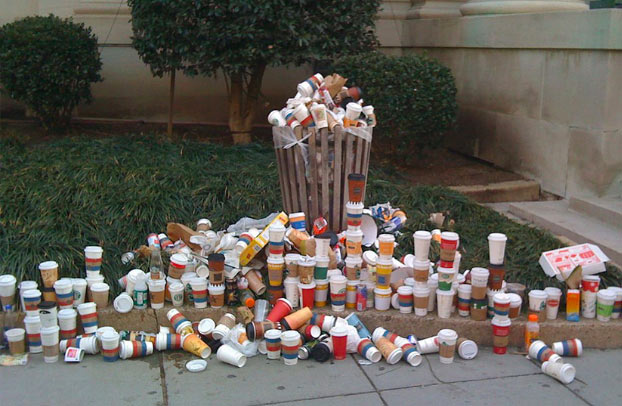
The last few decades have seen an explosion in the popularity of coffee shops. In the year 2000 in the UK, there were only 5,000 coffee shops in the country, while in 2018 that number now stands at over 20,000.
A report in 2011 found that 2.5 billion disposable coffee cups are used every year in the UK, which equates to 30,000 tonnes of coffee cup waste each year.
Drinking coffee on-the-move has become embedded in the culture of the Western world.
To help prevent leaks and ensure the liquid does not soak into the paper, disposable coffee cups are usually lined with polyethylene (plastic). This makes the cup stronger, but also means the cups can only be recycled at a specialist recycling centre, and are not suitable for kerbside recycling. Less than 0.25% of disposable coffee cups in the UK are recycled. Over 500,000 of them end up as litter every day.
Recycling facilities often do not accept coffee cups for recycling, because the plastic has been contaminated.
2. Clothing
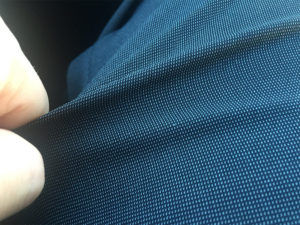
In the UK, it is estimated that two-thirds of clothing is made from plastic material, such as polyester, nylon and acrylic.
Every time these synthetic clothes are put into the washing machine, they shed tiny plastic fibres, which pass through wastewater treatment and into rivers and estuaries, and will often end up in the ocean.
According to a report by a group of Canadian scientists, plastic clothing fibres accounted for 74% of microplastic particles found in Canadian coastal areas.
Microplastics, such as the kind shed from clothing, are being ingested by fish and other marine life in our seas. The microplastics will then transfer to other animals when they are eaten, passing up the food chain, and can eventually wind up being eaten by humans. We could literally be eating the clothes we wear.
In 2018, a team of British scientists tested mussels from various locations around Britain. Every single mussel they tested contained microplastics. They estimated that for every 100g of mussels eaten by the consumer, 70 microplastic particles would be ingested.
3. Teabags
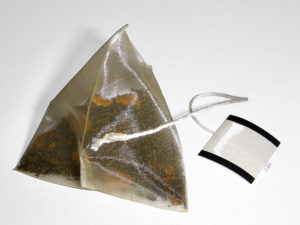
Most major brands of teabags are only around 70% biodegradable. The remaining 30% is due to the plastic net that helps hold the tea in the bag, made from heat-resistant polypropylene.
PG Tips, a major manufacturer of teabags in the UK responded to the findings by saying “Like most of the teabags in the UK, our teabags are made with about 80% paper fibre, which is fully compostable along with the tea leaves contained in the bag. The remaining packaging includes a small amount of plastic which is not fully biodegradable.”
In the UK, 165 million cups of tea are drunk every day.
Harriet Kopinska, the home composting project coordinator at Garden Organic, said: “We would still tell people to put teabags in their compost, as composting is the better environmental option. But where possible tear the bags first. Even better, use loose tea.”
4. Chewing Gum
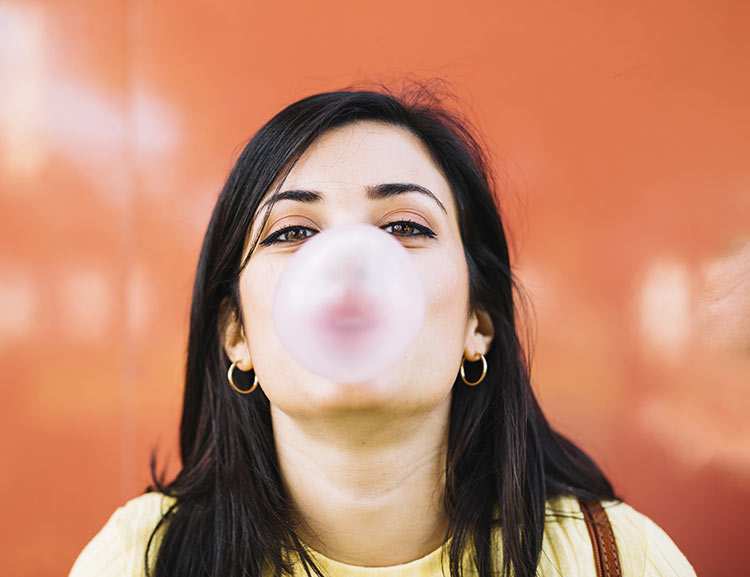
Chewing gum is not a new invention. In fact, 6,000-year-old chewing gum, complete with teeth imprints, was discovered in Finland. Cultures all over the world have enjoyed chewing on gum-like substances, and modern humans are no different.
Except that, instead of chewing on substances derived from plants, grasses, or resins, most modern-day chewing gum now contains plastic.
Modern chewing gum is non-digestible and water-insoluble, which means that no matter how long you keep chewing, it will never break down. This is down to the ‘gum base’, which is usually a kind of synthetic rubber, also used to make car tyres.
More specifically, the key ingredient in chewing gum is polyvinyl acetate, which is also used in the production of glue. It acts as the gum base for some of the most popular types of chewing gum in the UK.
Due to the incredible durability of plastic, it means chewing gum is very difficult to get rid of. Since plastic does not biodegrade, littered chewing gum will remain in the place it was dropped until it is cleaned up. Keep Britain Tidy estimate that 95% of UK streets are stained with discarded gum.
5. Foil Packaging
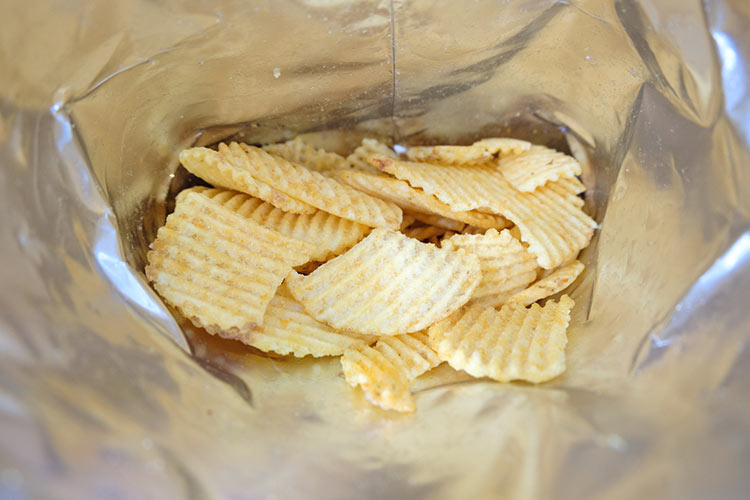
‘Foil’ packets, such as the kind used for crisp packets, are not made of metal foil, but metallised plastic film. This makes them unsuitable for normal kerbside recycling, as the thin foil can cause jams in the recycling machinery.
Walkers, the largest crisp manufacturer in the UK, produces 7,000 non-recyclable crisp packets every minute. The only place these packets end up is in a landfill.
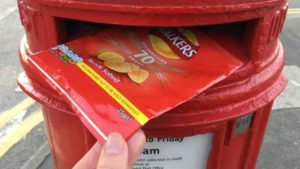
In response to this level of plastic waste, campaigners in Britain have been putting crisp packets into postboxes, which the Royal Mail has been obligated to deliver to Walkers. However, a Royal Mail spokesman has urged the public not to do this, stating: “Crisp packets can’t go through the machines, they are not normal mail items, therefore, my hardworking colleagues need to manually sort them.”
In December 2018, Walkers announced the launch of a nationwide recycling programme, claiming to be the first in Britain. Crisp packets can be posted to them free-of-charge to be recycled, or deposited at a local collection point.
This is a step in the right direction, but the fact remains that millions of crisp packets are being manufactured every year, without the infrastructure to recycle them.
6. Sea Salt

This one is unique on our list because unlike the others, plastic is not intentionally added to sea salt. Instead, sea salt has been contaminated with microplastics.
Researchers in South Korea found that up to 90 per cent of the table salt brands sampled worldwide contained microplastics.
Samples were taken of 39 table salt brands from countries in Europe, North America, South America, Africa and Asia. Of the 39 brands tested, 36 were found to contain microplastics. Brands from Asia were particularly high in microplastics, most likely because plastic pollution is particularly pervasive in Asia.
The same study estimates that an adult average consumes around 2,000 microplastic particles every year from eating salt.
And it doesn’t just stop with salt: many other foods and even the water that comes from our taps have been found to contain microplastics.
It is still unclear whether ingesting microplastics is harmful to human health – scientists are still studying it. What is certain, however, is that plastic is finding its way inside us from the food and drink we consume.
7. Paper or cardboard food and drink packaging
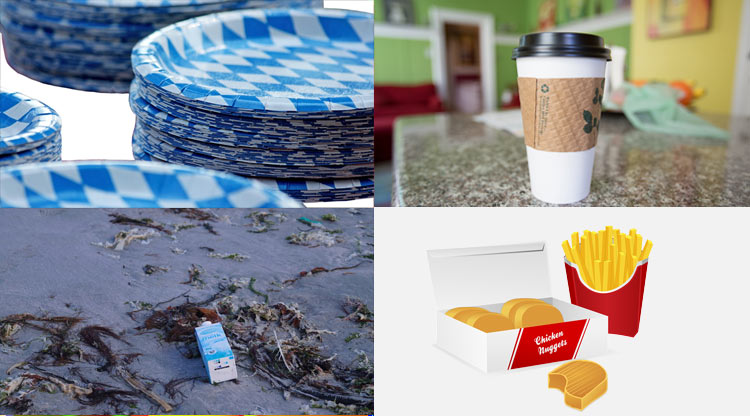
If you submerge a piece of paper or cardboard in water, it will become completely saturated and unsuitable for its intended purpose. Have you ever wondered, then, why ‘paper’ or ‘cardboard’ food and drinks containers do not behave in the same way? The answer is that a thin layer of plastic is used to coat the paper or cardboard.
The plastic is added to increase water resistance, tear strength and abrasion resistance.
Some of the most common applications of this process are:
- Milk and juice cartons
- Paper drinking cups
- Paper plates
- Paper bags
- Frozen food containers
8. Glitter
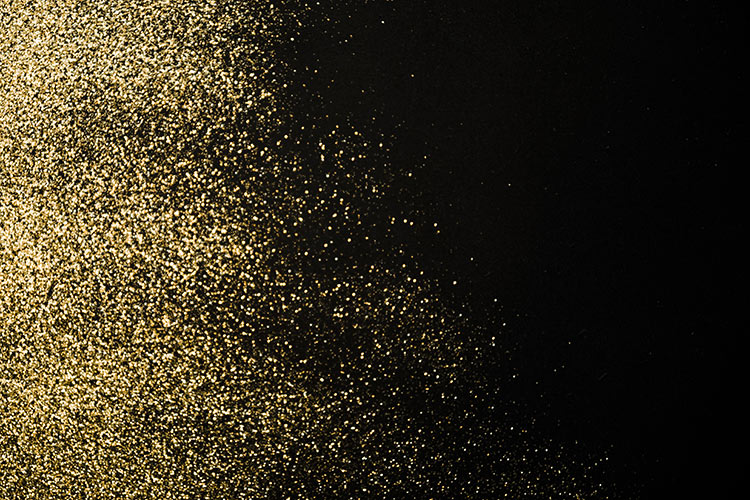
Most glitter is made from etched aluminium bonded to polyethylene terephthalate (PET). Because pieces of glitter are under 5 mm, they are classed as a form of microplastic.
Trisia Farrelly, an environmental anthropologist at Massey University in New Zealand has called for a total ban on the sale of glitter. She said: “All glitter should be banned because it’s microplastic and all microplastics leak into the environment.”
Because glitter is so small, when it is washed down a drain, it can bypass sewage filters and head straight out to sea.
Microplastics, such as glitter, have been observed being ingested by a wide range of marine life, including plankton, fish, shellfish and seabirds.
The microplastics can fill an animals stomach, giving it the mistaken feeling that it is full. But it is full up on plastic, and not receiving the nutrients it requires. This can often lead to an early death.
The good news is that environmentally-friendly alternatives to glitter exist. The UK brand Lush has begun to use ‘mica’, a man-made material designed to mimic the shimmery effect of glitter. Mica is made from natural minerals, which Lush say will not have the same adverse environmental impact as plastic-based glitter.
9. Cigarette Butts
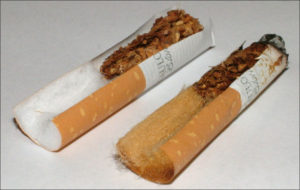
It’s a common misconception that cigarette butts are made solely of cotton. In fact, they contain cellulose acetate, the same kind of plastic that is used to make sunglasses, textiles, photographic film, and much more.
Cigarette butts are the most common type of litter in the world. A survey conducted by Keep America Beautiful found that 77% of Americans do not think of cigarette butts as litter.
An estimated 4.5 trillion cigarette butts are littered around the world each year. Collected together, they would weigh as much as 150,000 elephants.
Due to the frequency that they are littered on the street and their relatively small size, cigarette butts are frequently washed down drains and can make their way into the sea.
Cigarette butts were introduced in the 1950s in an attempt to address the growing concern that smoking is bad for human health. However, repeated scientific studies have concluded that filtered cigarettes are no less dangerous than filterless cigarettes.
10. Disposable wipes
Wet wipes are used all over the world for a wide range of purposes, such as cleaning up spills, changing nappies and removing stains. But did you know that most disposable wipes contain plastic?
Wet wipes are usually made by weaving together cotton and polyester. Adding polyester (plastic) makes the wipes stronger, but it means the wipes are not fully biodegradable.
Wet wipes are of particular concern due to the sheer number of them that are flushed down the toilet. A lot of people think that flushing wet wipes is no different than flushing toilet paper, but the truth is that wipes should never be flushed down the toilet.
Not only does it result in tonnes of extra plastic waste entering the ocean, but wet wipes are also the number one reason that drains and sewers become blocked. In fact, Water UK estimates that wet wipes make up 93% of the material that forms sewer blockages.
